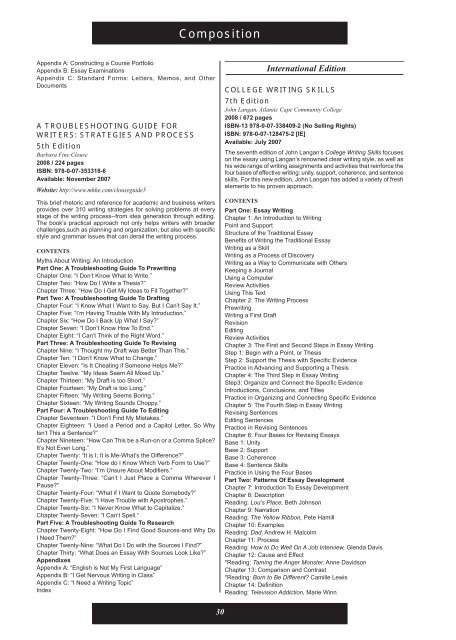ENGLISH - McGraw-Hill Books
ENGLISH - McGraw-Hill Books
ENGLISH - McGraw-Hill Books
Create successful ePaper yourself
Turn your PDF publications into a flip-book with our unique Google optimized e-Paper software.
CompositionAppendix A: Constructing a Course PortfolioAppendix B: Essay ExaminationsAppendix C: Standard Forms: Letters, Memos, and OtherDocumentsA TROUBLESHOOTING GUIDE FORWRITERS: STRATEGIES AND PROCESS5th EditionBarbara Fine Clouse2008 / 224 pagesISBN: 978-0-07-353318-6Available: November 2007Website: http://www.mhhe.com/clouseguide5This brief rhetoric and reference for academic and business writersprovides over 310 writing strategies for solving problems at everystage of the writing process--from idea generation through editing.The book’s practical approach not only helps writers with broaderchallenges,such as planning and organization, but also with specificstyle and grammar issues that can derail the writing process.CONTENTSMyths About Writing: An IntroductionPart One: A Troubleshooting Guide To PrewritingChapter One: “I Don’t Know What to Write.”Chapter Two: “How Do I Write a Thesis?”Chapter Three: “How Do I Get My Ideas to Fit Together?”Part Two: A Troubleshooting Guide To DraftingChapter Four: “I Know What I Want to Say, But I Can’t Say It.”Chapter Five: “I’m Having Trouble With My Introduction.”Chapter Six: “How Do I Back Up What I Say?”Chapter Seven: “I Don’t Know How To End.”Chapter Eight: “I Can’t Think of the Right Word.”Part Three: A Troubleshooting Guide To RevisingChapter Nine: “I Thought my Draft was Better Than This.”Chapter Ten: “I Don’t Know What to Change.”Chapter Eleven: “Is It Cheating if Someone Helps Me?”Chapter Twelve: “My Ideas Seem All Mixed Up.”Chapter Thirteen: “My Draft is too Short.”Chapter Fourteen: “My Draft is too Long.”Chapter Fifteen: “My Writing Seems Boring.”Chapter Sixteen: “My Writing Sounds Choppy.”Part Four: A Troubleshooting Guide To EditingChapter Seventeen: “I Don’t Find My Mistakes.”Chapter Eighteen: “I Used a Period and a Capitol Letter, So WhyIsn’t This a Sentence?”Chapter Nineteen: “How Can This be a Run-on or a Comma Splice?It’s Not Even Long.”Chapter Twenty: “It is I; It is Me-What’s the Difference?”Chapter Twenty-One: “How do I Know Which Verb Form to Use?”Chapter Twenty-Two: “I’m Unsure About Modifiers.”Chapter Twenty-Three: “Can’t I Just Place a Comma Wherever IPause?”Chapter Twenty-Four: “What if I Want to Quote Somebody?”Chapter Twenty-Five: “I Have Trouble with Apostrophes.”Chapter Twenty-Six: “I Never Know What to Capitalize.”Chapter Twenty-Seven: “I Can’t Spell.”Part Five: A Troubleshooting Guide To ResearchChapter Twenty-Eight: “How Do I Find Good Sources-and Why DoI Need Them?”Chapter Twenty-Nine: “What Do I Do with the Sources I Find?”Chapter Thirty: “What Does an Essay With Sources Look Like?”AppendixesAppendix A: “English is Not My First Language”Appendix B: “I Get Nervous Writing in Class”Appendix C: “I Need a Writing Topic”IndexInternational EditionCOLLEGE WRITING SKILLS7th EditionJohn Langan, Atlantic Cape Community College2008 / 672 pagesISBN-13 978-0-07-338409-2 (No Selling Rights)ISBN: 978-0-07-128475-2 [IE]Available: July 2007The seventh edition of John Langan’s College Writing Skills focuseson the essay using Langan’s renowned clear writing style, as well ashis wide range of writing assignments and activities that reinforce thefour bases of effective writing: unity, support, coherence, and sentenceskills. For this new edition, John Langan has added a variety of freshelements to his proven approach.CONTENTSPart One: Essay WritingChapter 1: An Introduction to WritingPoint and SupportStructure of the Traditional EssayBenefits of Writing the Traditional EssayWriting as a SkillWriting as a Process of DiscoveryWriting as a Way to Communicate with OthersKeeping a JournalUsing a ComputerReview ActivitiesUsing This TextChapter 2: The Writing ProcessPrewritingWriting a First DraftRevisionEditingReview ActivitiesChapter 3: The First and Second Steps in Essay WritingStep 1: Begin with a Point, or ThesisStep 2: Support the Thesis with Specific EvidencePractice in Advancing and Supporting a ThesisChapter 4: The Third Step in Essay WritingStep3: Organize and Connect the Specific EvidenceIntroductions, Conclusions, and TitlesPractice in Organizing and Connecting Specific EvidenceChapter 5: The Fourth Step in Essay WritingRevising SentencesEditing SentencesPractice in Revising SentencesChapter 6: Four Bases for Revising EssaysBase 1: UnityBase 2: SupportBase 3: CoherenceBase 4: Sentence SkillsPractice in Using the Four BasesPart Two: Patterns Of Essay DevelopmentChapter 7: Introduction To Essay DevelopmentChapter 8: DescriptionReading: Lou’s Place, Beth JohnsonChapter 9: NarrationReading: The Yellow Ribbon, Pete HamillChapter 10: ExamplesReading: Dad, Andrew H. MalcolmChapter 11: ProcessReading: How to Do Well On A Job Interview, Glenda DavisChapter 12: Cause and Effect*Reading: Taming the Anger Monster, Anne DavidsonChapter 13: Comparison and Contrast*Reading: Born to Be Different? Camille LewisChapter 14: DefinitionReading: Television Addiction, Marie Winn30

















